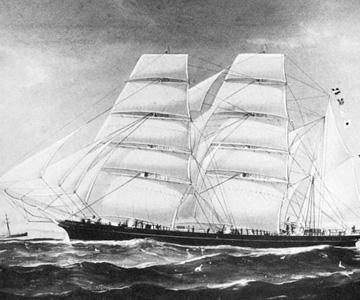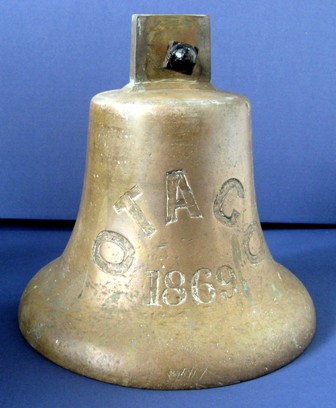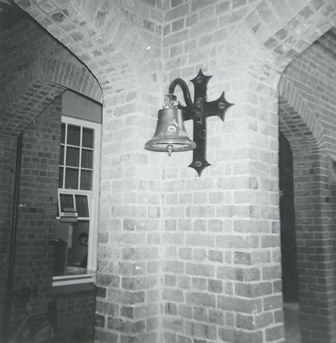OTAGO BELL 
Barque 'Otago' from 'Mirror of the Sea".
For some 30 years the Cloister at the Geelong College Senior School echoed to the bell of the ship, 'Otago'. Corroded, encrusted with pigeon droppings, this bell, incised with the name 'Otago' and its date of commissioning, tolled the timetable for thousands of students. Mystery shrouded the origins of this Bell, a mystery further confused by the existence of at least 3 ships bearing the name Otago during the latter part of the nineteenth century. It is one of two ship's bells held by the College - the other being the
'Saxon Onward' Bell.

Bell of the barque, Otago.
The 'Otago' Bell was originally donated to the College in 1932, thereby completing its worldwide odyssey. The March issue of the School Magazine
Pegasus of that year records the donation by A N Shannon through the generosity of Mr Hirst and Howard Smith Ltd. When originally installed at the College, monitors rang the Bell to indicate class times but, with the advent of electrical sirens, its use was discontinued. Pegasus of 1932 however, stated that the Bell was from the 'SS Otago', built at Glasgow, on the Clyde in 1863 and wrecked on route from Melbourne to New Zealand at Chasland’s Mistake, NZ in December, 1876. It implied that the Bell was recovered during salvage operations involving the urgent recovery of 5,000 ounces of gold. The real provenance and history of this Bell, however, is far more interesting and historically significant.
In 1869, a small three masted iron sailing barque of 367 tons was completed for the meticulous Captain Angus Cameron by the shipbuilding firm Alexander Stephen and Sons of Kelvinhaugh, Glasgow. In 1871, the barque visited Port Chalmers, New Zealand, under the command of Captain Cameron, himself a former resident of Port Chalmers. On this visit to New Zealand, the ship was prevented by the weather from entering Port Chalmers on the Otago peninsula. Cameron reluctantly gave in after 3 blustery days, paid the £10 fee for towing and, prophetically, allowed the steam-tug Geelong to tow the ship into harbour completing its journey. The satisfied Cameron then sold the ship to a group of South Australian shipowners and merchants. Later, on a voyage in 1886/7, the Otago’s Captain - John Snadden died, and was buried at sea in the ‘Gulf of Siam’. The ship proceeded to Bangkok where a newly commissioned captain, Joseph Conrad, took command. Joseph Conrad sailed to Singapore, then Melbourne and Sydney and through Torres Strait to Mauritius, then back to Adelaide, where Conrad left the ship and returned to England. The Otago continued a successful career but was finally acquired by the shipping company Huddard Parker and used as a coal hulk after 1903. In 1931 the vessel was abandoned - a sad derelict, near Mount Direction on the Derwent River about 10 kilometres above Hobart where the remains of the hulk are still visible in what is now known as Otago Bay.
Huddard Parker sold the vessel for £1 in late 1931 and the College acquired the Bell early the following year. Several other remnants of the ship exist. Her anchor is on display at Bicheno in Tasmania, the companionway to her officer’s cuddy is housed at the Hobart Maritime Museum and the ship’s wheel, recovered in 1946, was donated to the Honourable Company of Master Mariners, London.
 Wiki.jpg)
Hulk of the barque 'Otago' (Glover Image, 2008)

Joseph Conrad.
Joseph Conrad (1857-1924), the polish born Teodor Josef Konrad Nalecz-Korzeniowski, was to become a brilliant storyteller and an internationally renowned novelist. He acquired his new name, Joseph Conrad, shortly before taking command of the 'Otago'. He used his experiences aboard ship as settings for several of his novels and short stories. Many of his characters and stories have also lent themselves to other adaptations such as the account of the up-river saga of 'Heart of Darkness' transposed into the bleak 1979 film 'Apocalypse Now'. The ill-fated space freighter 'Nostromo' in the movie 'Alien', named after the title and main character of one of Conrad’s books share similar destructive fates. His book, 'Shadowline', recounting the ordeal of a new captain taking over from his dead predecessor appears to include much of Conrad’s experience aboard the Otago which he commanded in 1887/8. Set in the Gulf of Siam, his initial elation at gaining command turns to a bleak desolation as his malaria infested crew succumb to a listless disability and madness on the becalmed ship.
Several possible images of the barque 'Otago' exist but unfortunately, few have sufficient provenance to clearly identify them as Joseph Conrad’s ship of the time. A cover image on the original edition of his book
Mirror of the Sea may be that of the barque 'Otago'. A similar painting is held by the National Library of Australia.

The 'Otago' Bell in its original position in the Cloister
The Otago Bell has continued to lead a colourful life in the School and has gone ‘missing’ on 2 occasions - in 1951 and 1985, though fortunately, to be returned each time. Following cleaning of the bell and restoration of the supporting bracket the Otago Bell will be remounted in a more secure location.
Sources: Otago Hobart Image - Alan Glover, 2008.